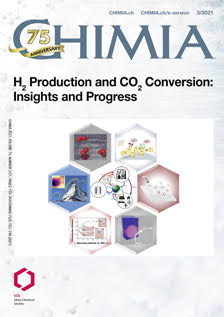Unwrap Them First: Operando Potential- induced Activation Is Required when Using PVP-Capped Ag Nanocubes as Catalysts of CO₂ Electroreduction
DOI:
https://doi.org/10.2533/chimia.2021.163PMID:
33766198Keywords:
Catalyst activation, Co2 reduction, Electrocatalysis, Nanoparticles, Polyvinylpyrrolidone (pvp)Abstract
Metallic nanoparticles of different shape can be used as efficient electrocatalysts for many technologically and environmentally relevant processes, like the electroreduction of CO2. Intense research is thus targeted at finding the morphology of nanosized features that best suits catalytic needs. In order to control the shape and size distribution of the designed nanoobjects, and to prevent their aggregation, synthesis routes often rely on the use of organic capping agents (surfactants). It is known, however, that these agents tend to remain adsorbed on the surface of the synthesized nanoparticles and may significantly impair their catalytic performance, both in terms of overall yield and of product selectivity. It thus became a standard procedure to apply certain methods (e.g. involving UV-ozone or plasma treatments) for the removal of capping agents from the surface of nanoparticles, before they are used as catalysts. Proper design of the operating procedure of the electrocatalysis process may, however, render such cleaning steps unnecessary. In this paper we use poly-vinylpyrrolidone (PVP) capped Ag nanocubes to demonstrate a mere electrochemical, operando activation method. The proposed method is based on an observed hysteresis of the catalytic yield of CO (the desired product of CO2 electroreduction) as a function of the applied potential. When as-synthesized nanocubes were directly used for CO2 electroreduction, the CO yield was rather low at moderate overpotentials. However, following a potential excursion to more negative potentials, most of the (blocking) PVP was irreversibly removed from the catalyst surface, allowing a significantly higher catalytic yield even under less harsh operating conditions. The described hysteresis of the product distribution is shown to be of transient nature, and following operando activation by a single 'break-in' cycle, a truly efficient catalyst was obtained that retained its stability during long hours of operation.
Downloads
Published
Issue
Section
License
Copyright (c) 2021 María de Jesús Gálvez-Vázquez, Heng B Xu, Pavel A Moreno-García, Yuhui A Hou, Huifang A Hu, Benjamin J. Wiley, Soma Vesztergom, Peter Broekmann

This work is licensed under a Creative Commons Attribution 4.0 International License.







